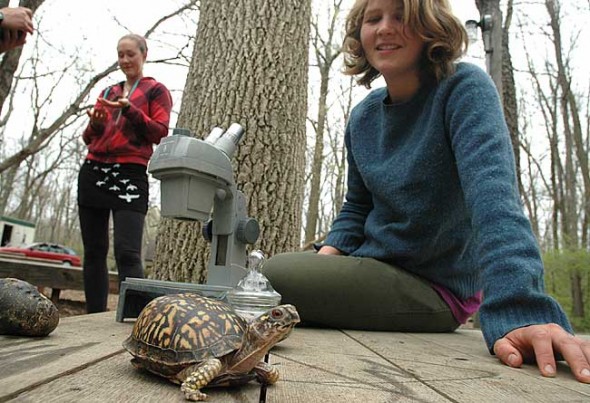
Nine of Glen Helen’s seasoned naturalists will lead a series of hands-on, family-friendly programs for Earth Day, Saturday, April 23, including a Tiny Things workshop led by naturalist Kathleen Soler, with Hannah Brewster at left. Events take place at the Outdoor Education Center and Raptor Center beginning at 8 a.m. with a youth and family fun run, followed by programs on fossils, backyard birds and Ohio wildlife. Events run until 2 p.m. (Photo by Lauren Heaton)
A closer look at the Glen
- Published: April 28, 2011
The nine naturalists who came last August to live in Glen Helen and lead the preserve’s educational programs throughout the year have grown fond of their home in the woods. They know the sounds, the smells, the insides and underneaths of one of Ohio’s native woodland areas, and have gained great respect for this ecosystem and the life forms it supports. This Saturday, April 23, they will be in the Glen to share their expertise with the community for a fun-filled Earth Day.
Jesse Varga came to the Glen in 2009 with a keen eye for fossils. After graduating from Earlham College and spending a year as a naturalist, he now serves as the Raptor Center assistant. And though he loves birds and biology, his true passion lies hidden underground, where the rocky imprints of prehistoric trilobites, brachiopods and bryozoans are found. He will lead a program on Saturday called Fossils of Ohio, during which participants can check out the Antioch College geology department’s 18-inch specimen of an isotelus trilobite fossil and use the charts Varga will provide to trace in history the periods that other fossilized species roamed this part of the continent thousands of years ago.
“We’ll talk about how fossils are made and how they’re so cool and why this area of Ohio is such an exciting place to find them,” Varga said last week.
Next to him, naturalist Kathleen Soler looked through her stereoscope at an alien-looking hairy tentacle with pink and green stripes. It turns out that the monster was really a sprouted acorn she had found in the Glen. She and Hannah Brewster will lead a Tiny Things event focused on the details that, while difficult to see with the naked eye, when seen up close make the woods we all grew up in seem like foreign worlds yet to be discovered.
“Through a magnifying lens, you see things you’d not even know are there,” she said.
Soler gained a new respect for ants after cataloguing species at the Chicago Field Museum. “From far away, ants are boring, but up close they’re complicated,” she said.
According to naturalist Ingrid Brofman, who is leading a program with Margaret Kane on Ohio’s furry and scaly wildlife, just taking the time and care to really see these organisms and understand the way they function helps one to appreciate them. And if residents appreciate the importance of these life forms, perhaps they will keep trying to protect them, she said.
“Caring about the environment starts by being excited about it in the first place,” Brofman said.
Naturalist Peter Moorehouse, who spent nine months rehabilitating Desert Tortoise habitat in Southern California before coming to the Glen, will show Earth Day participants how to read cloud formations and barometric tools to predict the weather. Naturalist Susan Delfs will show visitors how to identify common backyard birds, while Stephanie Falzone and Matthew Herron will help residents to explore how pollinators help to keep the ecosystems in our backyards going strong.
The Yellow Springs News encourages respectful discussion of this article.
You must login to post a comment.
Don't have a login? Register for a free YSNews.com account.













No comments yet for this article.